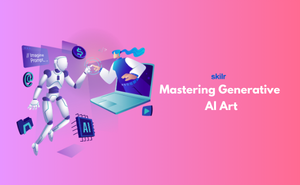👇 CELEBRATE CLOUD SECURITY DAY 👇
00
HOURS
00
MINUTES
00
SECONDS

Generative AI Art refers to the process of using AI systems to generate artwork automatically from text, ideas, or reference styles. With the help of these tools, users can transform written descriptions into realistic, abstract, or stylized images. This makes art creation more accessible to anyone, regardless of whether they have traditional artistic training.
What makes Generative AI Art powerful is its ability to blend imagination with advanced technology. From personal projects to professional design needs, it helps individuals and organizations produce high-quality visuals in less time. Mastering the basics of Generative AI Art provides a pathway for exploring new creative opportunities and building innovative careers in digital content creation.
This exam is ideal for:
Domain 1 - Introduction to Generative AI Art
Domain 2 - How AI Creates Art
Domain 3 - Prompt Engineering for Art
Domain 4 - Applications of Generative AI Art
Domain 5 - Ethical Considerations
Domain 6 - Exploring Styles and Creativity
Domain 7 - Future of AI in Art
Industry-endorsed certificates to strengthen your career profile.
Start learning immediately with digital materials, no delays.
Practice until you’re fully confident, at no additional charge.
Study anytime, anywhere, on laptop, tablet, or smartphone.
Courses and practice exams developed by qualified professionals.
Support available round the clock whenever you need help.
Easy-to-follow content with practice exams and assessments.
Join a global community of professionals advancing their skills.
Prompt-writing, AI art basics, ethical use, and creative application skills.
Design, advertising, gaming, social media, and product development.
Yes, but with attention to licensing and ethical considerations.
Yes, it builds creativity and tech awareness for future careers.
It’s the skill of writing clear instructions to guide AI in creating desired visuals.
It makes art creation faster, more accessible, and opens new creative possibilities.
Digital artist, creative designer, AI art consultant, or content creator.
No, even beginners with no drawing skills can learn it.
It learns from patterns in images and generates new visuals based on text descriptions.
For personal creativity, marketing, branding, social media, or concept design.